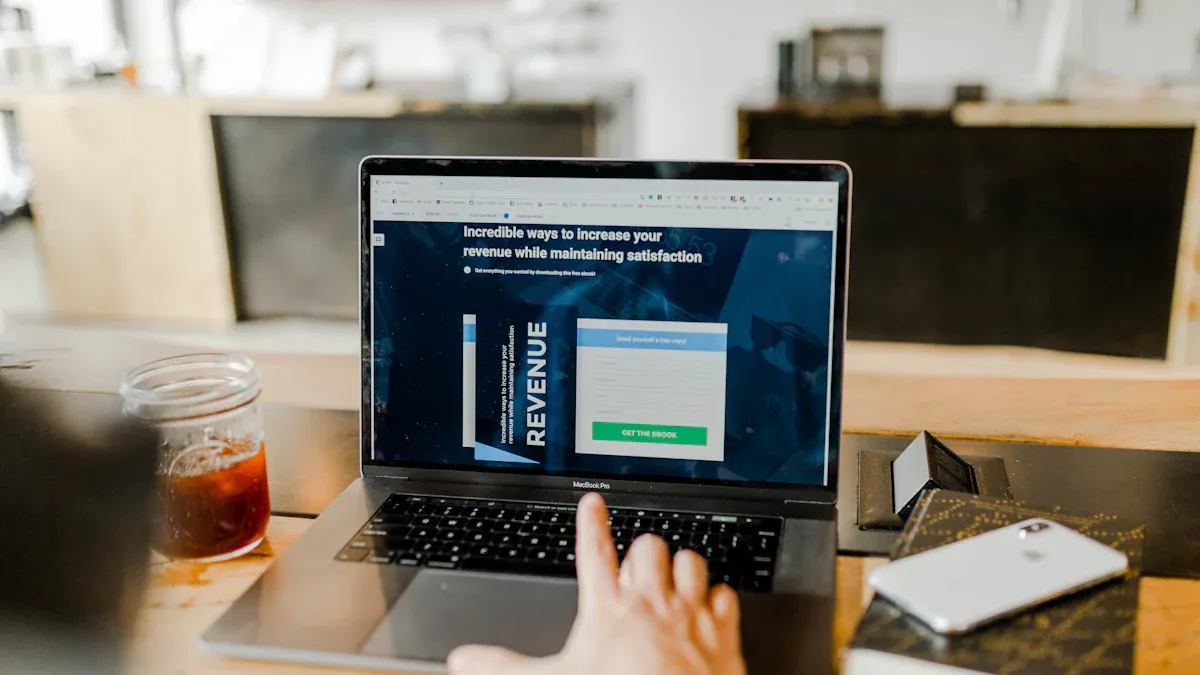How to Maximize the ROI of Your ATS Investment

Investing in an ATS can significantly enhance your hiring process. Understanding the ROI of Implementing an ATS is crucial, as the advantages extend beyond mere cost savings. It enables you to hire more quickly, discover higher-quality candidates, and retain employees for longer periods. For example, organizations that utilize an effective ATS operate 30% faster and retain 60% more of their workforce. By monitoring metrics such as hiring duration and candidate satisfaction, you can maximize the benefits of your ATS. Leveraging data and refining your processes will ensure that your ATS delivers a strong return on investment.
Key Takeaways
Using an ATS can make hiring 30% faster and keep 60% more employees.
Check your ATS success by comparing hiring time and costs before and after using it.
Make clear goals for your ATS, like saving money or finding better workers.
Use data to watch hiring numbers and find ways to make recruiting better.
Train your team often on how to use the ATS so they can get the most out of it and hire better.
Measuring the ROI of Using an ATS
What is ATS ROI?
ATS ROI means the benefits your company gets compared to its cost. It shows how well the system improves hiring. To find ROI, use this formula: ROI = (Benefits Value - ATS Cost) / ATS Cost * 100. This helps you see the return and find ways to improve. For example, companies with ATS often cut hiring time by 40%.
You can measure ATS ROI by comparing hiring time and costs before and after using it. Looking at industry averages also gives helpful information. A detailed cost-benefit check helps you balance the system's costs and gains.
Why Checking ROI is Important
Knowing your ATS ROI shows how it helps your hiring plans. It reveals time and money savings, so you can use resources better. For example, ATS tools handle boring tasks, letting HR focus on bigger goals. Checking things like candidate quality and system use ensures it meets your needs.
Tracking ROI also proves your ATS is worth the money. By showing time and cost savings, you can explain its value to others. This keeps your ATS delivering good results.
Important ATS ROI Metrics
Time-to-Hire
Time-to-hire is how long it takes to fill a job. Shorter times mean faster hiring. Companies with ATS often hire quicker, boosting productivity.
Cost-Per-Hire
Cost-per-hire is the total hiring expense. ATS lowers costs by automating tasks and improving ad spending. Companies save money by skipping manual work.
Quality of Hire
Quality of hire checks how well new workers perform and stay. ATS helps by matching candidates to jobs. Better hires save money and help the company grow.
Candidate Experience
Candidate experience is how applicants feel about your hiring process. Surveys and feedback measure this. ATS makes applying easier, keeping candidates happy and attracting great talent.
Strategies to Maximize Recruiting ROI

Set Clear Objectives
Match ATS Goals to Hiring Needs
To get the most from your ATS, match its goals to your hiring needs. First, decide what you want the system to do. Do you need faster hiring, better candidates, or lower costs? Each goal should solve a specific problem your company faces. By focusing on these goals, your ATS can help improve hiring and show clear results.
Goal | What It Helps With |
|---|---|
Faster hiring | Fill jobs quickly to keep your team strong. |
Better candidates | Find people who fit your company and job roles. |
Easier recruitment | Manage many applicants without losing quality. |
Save money by automating tasks and using resources wisely. | |
Accurate records | Keep updated candidate info for smarter choices. |
Growth preparation | Use an ATS that grows with your company. |
Follow rules | Stay within legal hiring guidelines. |
Pick Success Measurements
Choosing success measurements helps you track how well your ATS works. Metrics like hiring speed, cost, and candidate quality give useful information. Set short-term and long-term goals to see progress. For example, aim to cut hiring costs by 20% in a year or boost candidate satisfaction by 15%. Checking these numbers often ensures your ATS stays valuable.
Use Data Insights
Track Results with Analytics
Data tools help make hiring better. Use analytics to watch numbers like time-to-fill and candidate happiness. Companies using data-driven hiring improve quality 2.5 times more often. For example, one tech company hired faster and kept workers longer by studying traits of good employees. Tracking results helps you make smart choices and improve hiring plans.
Fix Problems in Hiring
Data also shows where hiring slows down. If interviews take too long, change the process to save time. Companies that focus on time-to-fill often keep new hires 38% longer. Fixing problems makes hiring smoother for both your team and candidates.
Make Sure Teams Use the ATS
Train Teams Well
Training is key to getting the most from your ATS. Teach your team how to use it properly. For example, one company used in-app guides to train faster and build confidence. A trained team uses the system better, leading to improved hiring results.
Use the ATS Daily
Using the ATS every day is just as important. Add it to daily tasks so it becomes a regular tool. One company added support directly into their ATS workflow to encourage use. Regular use helps collect good data, work faster, and reach hiring goals.
Combine ATS with Other Tools
Link ATS to CRM and HRIS
Connecting your ATS to tools like CRM and HRIS makes hiring easier. This connection lets systems share data without extra typing or mistakes. For example, linking your ATS to a CRM tracks how you talk to candidates. Connecting it to an HRIS moves candidate info straight into employee files. These links save time and make hiring smoother, making your ATS more useful.
Create Smooth Workflows
Linking tools together makes tasks faster and simpler. For example, when your ATS connects to job boards, it posts jobs and collects applications in one spot. This saves time switching between websites. Linked systems can also make reports, like where good hires come from or why candidates leave. These reports help you improve hiring and get better results. By creating smooth workflows, you can focus on finding great workers instead of boring tasks.
Improve Candidate Experience
Make Messages Personal
Sending personal messages helps candidates feel special. Use your ATS to send messages that match each person. Candidates who get personal messages are more likely to like your company. Companies using smart ATS tools see happier candidates and better reviews. By focusing on candidate happiness, you attract great workers and keep them longer.
Make Applications Easy
Hard applications can scare people away. Use your ATS to make applying simple by cutting extra steps. Features like autofill or resume uploads make it faster for candidates. Easy applications make candidates happier and bring in more good applicants. Simplifying the process is a quick way to improve hiring and save money.
Boost ATS Performance
Check Your ATS Often
Checking your ATS often makes sure it works well. Look at how much your team uses it and ask for feedback. For example, track where good hires come from or why candidates stop applying. Use your ATS to check for hiring rule mistakes automatically. These checks keep your system working well and following the rules.
Improve Based on Feedback
Feedback from your team and candidates helps make your ATS better. Use their ideas to fix problems, like making it easier to use or adding new tools. Regular updates keep your ATS helpful and matching your goals. For example, fixing hard-to-use parts makes everyone happier. By improving your ATS, you make sure it stays worth the cost.
Overcoming Problems in ATS Setup
Setting up an ATS can improve hiring, but problems like fear of change, no clear goals, and tool connection issues can happen. Fixing these problems helps your ATS work better and makes hiring easier.
Fear of Change
Fear of change is a big problem with new tools. Workers might feel nervous or unsure about using the ATS. To fix this, you need a clear plan to help them adjust.
Ways to Help Teams Adjust
Having a strong team for setup is important. Each person has a job to make sure the ATS works well. Here’s what they do:
Role | Job |
|---|---|
Project Sponsor | Supports the ATS setup and helps the team succeed. |
Project Manager | Manages the setup steps, keeps things on track, and meets deadlines. |
HR Stakeholders | Shares ideas about needs, workflows, and how users will use the system. |
IT Lead | Handles tech tasks like setting up the system and moving data. |
Training Coordinator | Creates training plans, teaches users, and gives ongoing help. |
Vendor Representatives | Works with the ATS company to solve tech problems and ensure smooth setup. |
User Representatives | Shares feedback to make sure the ATS fits their needs. |
By including key people and giving good training, you can make the change easier and get everyone to use the ATS regularly.
No Clear Goals
Without clear goals, it’s hard to see if your ATS is working. This can waste time and miss chances to improve.
Setting and Watching Goals
Watching key goals helps you see how well your ATS works. Focus on these types:
Goal Type | What It Measures |
|---|---|
Tracks how often recruiters use the ATS and for what tasks, like posting jobs. | |
Data quality goals | Checks how accurate the ATS data is, like resumes and application errors. |
Performance goals | Measures how well the ATS helps hire people, like time-to-fill and how many candidates get hired. |
Checking these goals often makes sure your ATS matches your hiring plans and gives good results.
Tool Connection Problems
Problems connecting tools can slow down work and make the ATS less useful. Making sure tools work together is key for smooth hiring.
Making Tools Work Together
Connecting your ATS with other tools, like CRM and HRIS, makes hiring tasks easier. For example, automating data entry and scheduling interviews saves time and avoids mistakes. Studies show 94% of HR workers think ATS connections help hiring, and 86% say it cuts hiring time. But, 70% of tech changes fail because of bad planning. A clear plan for connecting tools makes your ATS more helpful and shows its value to your team.
Poor Candidate Experience
Making the Candidate Journey Better
A bad candidate experience can hurt your company’s image. It can also make your ATS less useful. Long applications, unclear updates, or slow hiring upset candidates. Fixing these problems helps you attract great workers and get more from your ATS.
Start by making applications easier. Don’t ask for the same details twice. Use tools like autofill to save time. Clear updates are also important. Let candidates know their status to reduce stress and build trust.
Improving interviews leaves a good impression. Use your ATS to schedule interviews smoothly. Let candidates pick times that work for them. This shows respect and speeds up hiring. Quick decisions also matter. Collect feedback in your ATS to avoid delays and keep top candidates interested.
Personal messages make candidates feel special. Use your ATS to send updates that match each person. This builds a good connection with your company. Linking your ATS to other tools, like calendars and HR systems, makes work faster. Recruiters can find all candidate info in one place and work better with teams.
The table below shows ways to improve the candidate journey:
Improvement Feature | Description |
|---|---|
Easier Application Process | Cuts repeated steps, making it simple for candidates. |
Better Communication | Sends updates quickly, reducing confusion. |
Smoother Interviews | Makes interviews easy and leaves a good impression. |
Faster Hiring Decisions | Speeds up choices to secure great candidates. |
Personal Messages | Sends updates that make candidates feel valued. |
Linked Calendar Systems | Lets candidates pick interview times easily. |
Centralized Candidate Info | Keeps all details in one place for better efficiency. |
Team Collaboration | Shares feedback quickly among hiring teams. |
Faster Offer Process | Automates offers to save time. |
Stronger Employer Image | Builds a good reputation with a smooth hiring process. |
By improving these areas, you create a better experience for candidates. This boosts your ATS results and strengthens your hiring process.
Getting the most from an ATS needs a smart plan. Start by setting clear goals, like hiring faster or finding better candidates. Use data to check numbers like hiring costs and job offer success. Fix problems in the system and connect it with other tools. Training teams on ATS can cut hiring time by 20%. Systems that work well together make hiring 30% more efficient. Check your ATS often to make sure it meets your hiring goals and stays useful.
FAQ
What is the main benefit of using an ATS?
An ATS makes hiring easier and faster. It cuts down on manual work and improves candidate quality. You can also track things like hiring time and costs to make better choices.
How do you measure the ROI of an ATS?
To find ROI, compare the system's benefits to its costs. Use this formula:ROI = (Benefits Value - ATS Cost) / ATS Cost * 100.
Check numbers like hiring time, costs, and candidate happiness to see how well it works.
How can you ensure your team adopts the ATS?
Train your team well and give them support. Show them how the ATS makes their work easier. Add it to daily tasks so they use it often. Explain how it saves time and improves hiring results.
Can an ATS improve the candidate experience?
Yes, it can. An ATS makes applying simple and sends personal messages. It also gives updates quickly. Candidates like a clear and easy process. A good experience helps your company attract great workers.
What should you do if your ATS isn’t meeting expectations?
Check how well it’s working. Look for problems by doing audits. Ask your team and candidates for feedback. Use their ideas to fix issues or think about getting a better system.
From recruiting candidates to onboarding new team members, MokaHR gives your company everything you need to be great at hiring.
Subscribe for more information

